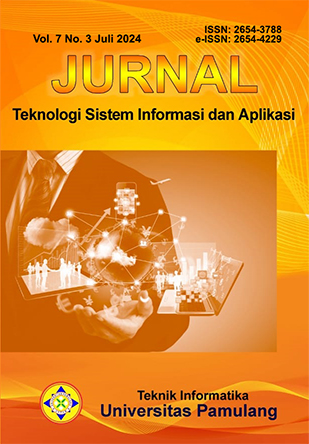Penerapan Metode EUCS terhadap Kepuasan Pengguna Sistem Informasi Akademik
DOI:
https://doi.org/10.32493/jtsi.v7i3.41296Keywords:
EUCS Method; User Satisfaction; Academic Information SystemAbstract
In processing the student academic information system, an academic information system is needed on the Pelalawan Indonesia Plantation Technology Institute campus, which has been implemented since 2018. Since its implementation, there have still been several obstacles or problems experienced by users, such as repeated data entry when filling out lecturer and service performance questionnaires, menus that are not yet optimal. , menu structures that are difficult to understand and the need to add new menus, data processing that takes quite a long time and even errors occur. This research uses the EUCS method which aims to see the level of user satisfaction with the academic information system with a sample size of 75 people who are active students at the ITP2I campus. After conducting research, it was found that the level of user satisfaction with the academic information system was in the moderate range with a value of 0.648. Of the five hypotheses tested, two hypotheses were accepted. The two accepted hypotheses are that the Ease of Use and Format factors have a significant influence on user satisfaction. Meanwhile, three other hypotheses, namely Accuracy, Content and Timeliness, were rejected because they did not have a significant influence on user satisfaction.
References
Ariska, A. S., & Sanjaya, M. R. (2023). Analisis Tingkat Kepuasan Pengguna Aplikasi Sistem Informasi Akademik (SIAKAD) Berbasis Website Menggunakan Metode End-User Computing Satisfaction (EUCS). Indonesian Journal of Computer Science, 12(6), 4038.
Fadlan, M., Syafiqoh, U., Rosmini, & Asmah. (2020). Evaluasi Kualitas Sistem Informasi Akademik STMIK PPKIA Tarakanita Rahmawati Dengan Metode WebQual. Jurnal Politeknik Caltex Riau, 6(1), 59-68.
Golo, Z. A., Subinarto, & Garmelia, E. (2021). Analisis Tingkat Kepuasan Pengguna Sistem Informasi Puskesmas Menggunakan Metode End User Computing Satisfaction ( EUCS ) di Puskesmas. Jurnal Rekam Medis dan Informasi Kesehatan, 4(1), 52-56.
Kamaluddin, M. H., & Suyatno, D. F. (2020). Analisis Kepuasan Pengguna Sistem Informasi Akademik Terpadu (SIAKADU) Di Universitas Negeri Surabaya. Jurnal Manajemen Informasi, 11(1).
Perdana, A., Utami, M., & Aini, Q. (2021). End User Computing Satisfaction : Model Analisis Kepuasan Pengguna Aplikasi Menggunakan Partial Least Square Structural Equation Modeling. Jurnal Teknologi Informasi dan Ilmu Komputer, 8, 1237.
Saputra, A., & Kurniadi, D. (2019). Analisis Kepuasan Pengguna Sistem Informasi E-Campus Di IAIN Bukittinggi Menggunakan Metode EUCS. Jurnal Vokasional Teknik Elektronika dan Informatika, 7(3), 58-66.
Septiani, Y., Arribe, E., & Diansyah, R. (2020). Analisis Kualitas Layanan Sistem Informasi Akademik Universitas Abdurab Terhadap Kepuasan Pengguna Menggunakan Metode SEVQUAL (Studi Kasus : Mahasiswa Universitas Abdurrab Pekanbaru). Jurnal Teknologi dan Open Source, 3(1), 131-143.
Suwanti, Yudhana, A., & Herman. (2022). Analisis Kepuasan Pengguna Sistem Informasi Perpustakaan Menggunakan Metode End User Computing Satisfaction. Jurnal Teknologi dan Informasi, 12(2), 149-161.
Suzanto, B., & Sidharta, I. (2019). Pengukuran End-User Computing Satisfaction Atas Penggunaan Sistem Informasi Akademik. Jurnal Ekonomi, Bisnis & Entrepreneurship, 9(1), 16-28.
Yulandra, A. M., Muliana, R., & Firdaus. (2020). Analisis Implementasi Kawasan Teknopolitan di Kabupaten Pelalawan, Provinsi Riau. Jurnal Saintis, 20(1), 27-34.
Downloads
Published
How to Cite
Issue
Section
License
Copyright (c) 2024 M. Nur Amin, Eki Saputra, M. Luthfi Hamzah, Medyantiwi Rahmawita

This work is licensed under a Creative Commons Attribution-NonCommercial 4.0 International License.
Authors who publish with this journal agree to the following terms:
- Authors retain copyright and grant the journal right of first publication with the work simultaneously licensed under a Creative Commons Attribution License that allows others to share the work with an acknowledgement of the work's authorship and initial publication in this journal.
- Authors are able to enter into separate, additional contractual arrangements for the non-exclusive distribution of the journal's published version of the work (e.g., post it to an institutional repository or publish it in a book), with an acknowledgement of its initial publication in this journal.
- Authors are permitted and encouraged to post their work online (e.g., in institutional repositories or on their website) prior to and during the submission process, as it can lead to productive exchanges, as well as earlier and greater citation of published work (See The Effect of Open Access).
Jurnal Teknologi Sistem Informasi dan Aplikasi have CC BY-NC or an equivalent license as the optimal license for the publication, distribution, use, and reuse of scholarly work.
In developing strategy and setting priorities, Jurnal Teknologi Sistem Informasi dan Aplikasi recognize that free access is better than priced access, libre access is better than free access, and libre under CC BY-NC or the equivalent is better than libre under more restrictive open licenses. We should achieve what we can when we can. We should not delay achieving free in order to achieve libre, and we should not stop with free when we can achieve libre.
This work is licensed under a Creative Commons Attribution-NonCommercial 4.0 International (CC BY-NC 4.0) License
YOU ARE FREE TO:
- Share - copy and redistribute the material in any medium or format
- Adapt - remix, transform, and build upon the material for any purpose, even commercially.
- The licensor cannot revoke these freedoms as long as you follow the license terms



_2020_-_7(2)_2024_-_Thumbnail.png)












